Colour in nature: true blue Understand article
Have you ever seen a blue cow? A blue apple? Or a blue tree? Blue is rare in nature, so why are some plants and animals blue?
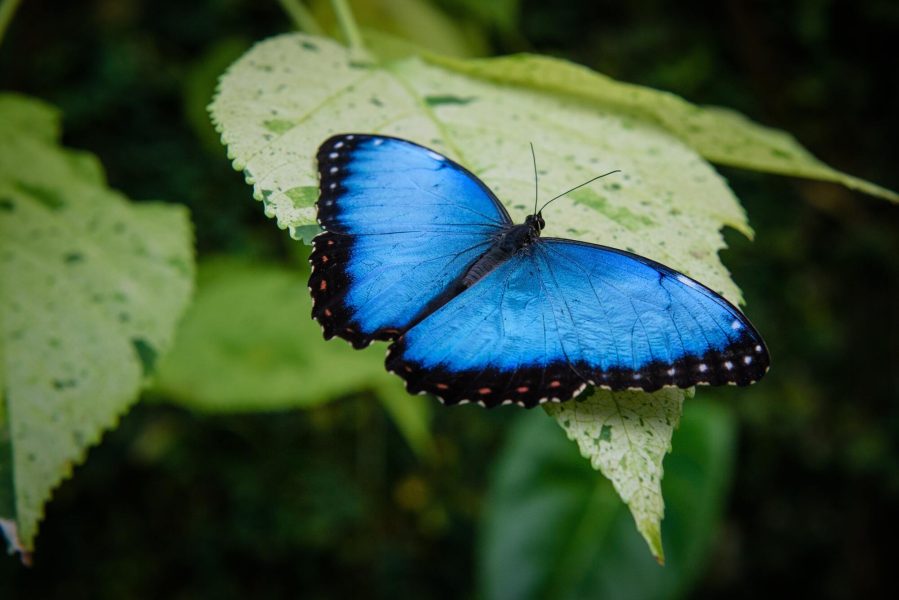
Where do colours come from? Sunlight contains all the colours in the visible part of the spectrum, as well as wavelengths that are invisible to humans. Coloured substances absorb particular wavelengths and reflect others. Our eyes perceive an object as blue when the reflected light has a wavelength between about 450 and 495 nm.[1]
Living things usually have the colours they do because it confers an evolutionary advantage. So, why is blue relatively rare in nature? Is it disadvantageous? And why do some plants and animals show shades of blue? Is it a mistake?
To answer these questions, we have to jump into chemistry, in particular the world of natural pigments!
Blue in the natural world: flowers and plants
Of more than 280 000 known flowering plant species, less than 10% produce blue flowers.[2,3]
In flowers, the blue colour comes from molecules that absorb the red part of the visible spectrum. These pigments are called anthocyanins, which comes from the Greek for “blue flower” (anthos=”flower” and kyanous=”dark blue”).
Anthocyanins are a class of water-soluble pigments that, depending on the pH, may appear red, purple or blue. This behaviour means that flowers with the same anthocyanin can have different colours depending on the pH of the soil.[4] This is because the blue colour is often the result of metal ions interacting with the anthocyanins in the petals to form chemical complexes, which alters the colour of the pigment. For example, the blue of cornflowers (Centaurea cyanus) comes from an anthocyanin called protocyanin, which together with another compound (a flavone) forms a pigmentation complex composed of six protocyanin molecules, six flavone molecules, a ferric iron ion, a magnesium ion and two calcium ions.
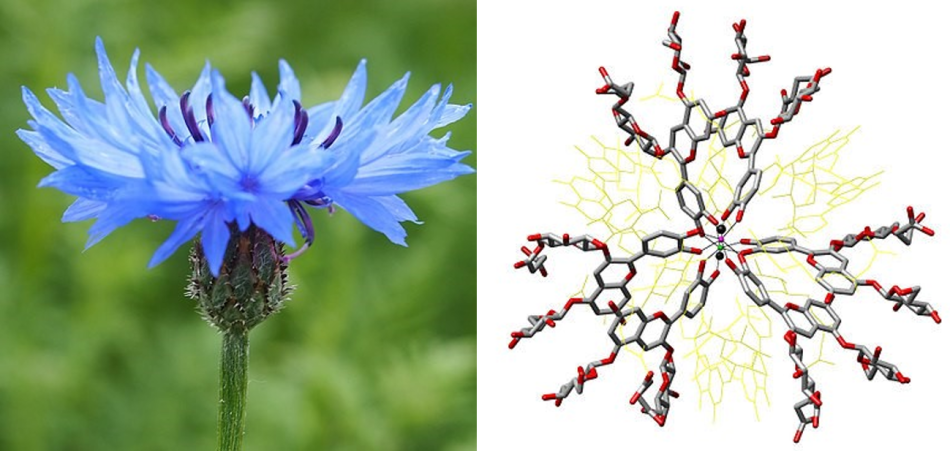
Images: Cornflower: Agnieszka Kwiecień/Wikipedia, CC BY 4.0. Protocyanin: Reproduced from Ref. [5]/Wikipedia, CC BY-SA 3.0
Soil pH can influence the absorption of metal ions by plants, which is why petal colour can be pH-dependent and some species can even show a range of colours in the same plant. For example, hydrangeas appear pink or red in basic soil (pH above 7), but appear blue at a lower pH (below 7) because the plant can absorb more aluminium ions from the soil.[6]
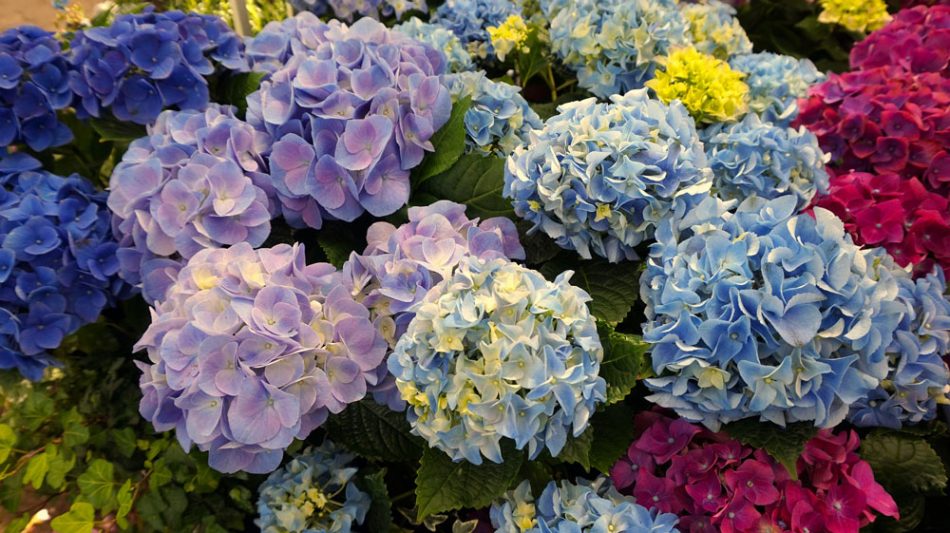
Image: Matthias Böckel/Pixabay
Another amazing example of blue in the plant world is the butterfly pea flower (Clitoria ternatea), which gets its colour from the anthocyanin delphinidin (which also gives blueberries their colour). The brilliant blue of this flower changes to purple in the presence of slightly acidic conditions and becomes hot pink as the acidity increases. For this reason, dried butterfly pea flowers are used to create colourful teas that can change colour, for example, with the addition of a lemon slice.[7]
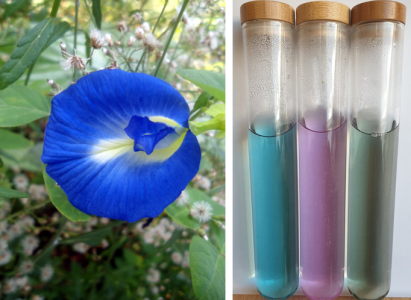
Images: Flower: N. Aditya Madhav/ Wikipedia, CC BY-SA 3.0. Tea: Courtesy of Marisa Prolongo
So why are some flowers blue? Many insects perceive colours differently than us. The photoreceptors in our eyes are sensitive to red, green and blue. Insects belonging to the bee family (Hymenoptera group) have receptors that are sensitive to green, blue and ultraviolet.[8] Blue flowers should thus be highly visible to these insect pollinators.
The animal world: when chemistry fails, physics comes to the rescue
If blue is rare in plants, it is even rarer in the animal world. However, there are some examples of blue animals: insects, reptiles, fish and even birds.
In this case, chemistry often has nothing to do with it; in fact most blue animals are not able to synthesize blue pigments,[9] although there are exceptions such as some frogs. For this reason, many animals resort to physics and the wonderful phenomenon of iridescence!
Iridescence is the phenomenon of certain materials changing colour depending on the angle of view or illumination. It occurs when an object’s physical structure causes light waves to combine with one another, a phenomenon known as interference. In constructive interference, light waves combine so that the crests and troughs line up to reinforce each other, increasing the vibrancy of the reflected colour. Destructive interference occurs when the crests and troughs cancel each other out to dim the colour. As the observer’s viewing angle shifts, the colours of the iridescent object change depending on the degree of constructive and destructive interference. For example, the concentric circular lines of pits on a CD’s surface are a similar size and spacing to the wavelength of visible light, which leads to colourful iridescence when light shines on it! A similar effect can be caused by thin transparent films, which is what gives soap bubbles their iridescent shimmer.
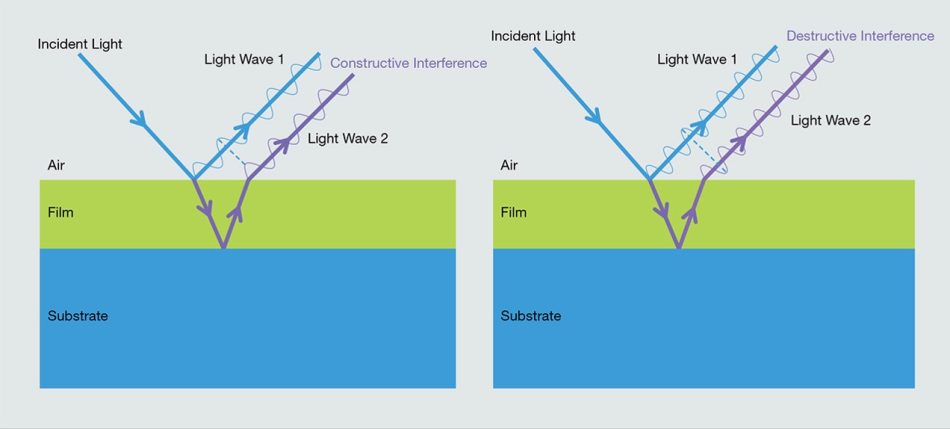
© GIA. Reprinted by permission
In the animal world, this effect can be produced by micro- and nanostructures present on the surface of the creature’s skin, shell or plumage. These need to be highly ordered to modulate the reflected light by amplifying/attenuating some frequencies more than others.
An example is the Western parotia bird of paradise (Parotia sefilata). The males have breast feathers that produce a beautiful iridescent blue colour because of flat, ordered and perfectly spaced nanostructures that align the light and amplify wavelengths at specific angles. The feather barbules (the fine fibres) have a V-shaped cross-section that receives light from different angles. The point of the structure reflects orange-yellow, whereas the sides reflect green-blue. This phenomenon, combined with a sort of dance ritual, is used to impress a potential mate.[10]
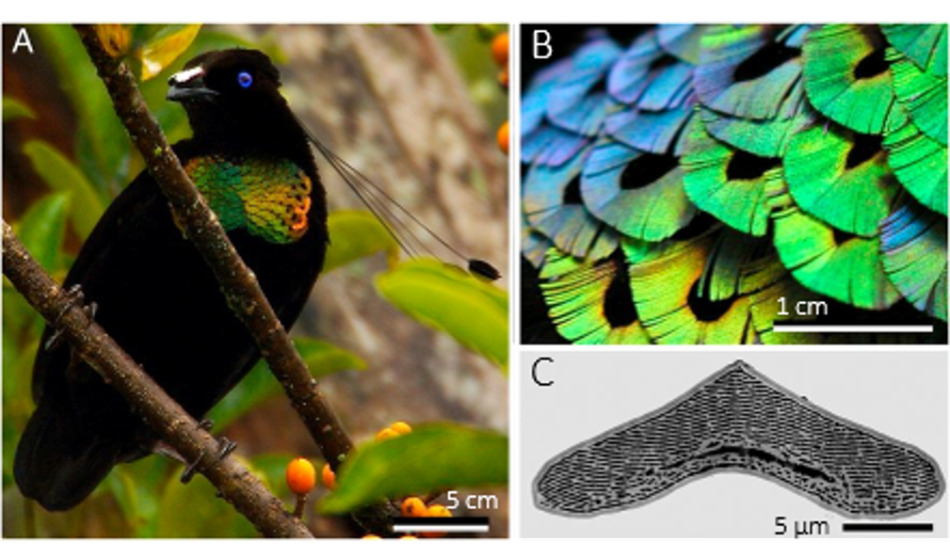
Image: Adapted with permission from PNAS
The multilayered structures of butterfly wings are another amazing example of iridescence. When you think of a blue butterfly, you probably picture the blue wings of the morpho butterfly Morpho menelaus. If you look at a morpho butterfly’s wings under a microscope, you see that they are covered with small scales with well-ordered surface structures that act like the Western parotia’s feather structure, reflecting light in amazing changing shades of blue on every wing flap.[12]

Image: Used with permission from SPIE
The same phenomenon is found in many fish, such as the blue damselfish (Chrysiptera cyanea) and the blue surgeonfish (Paracanthurus hepatus), which you might recognise as Dory from the Disney film Finding Nemo!
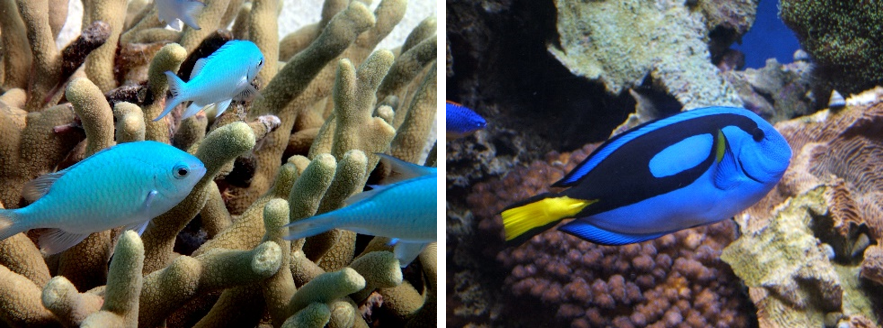
Images: Surgeonfish: Tewy/Wikimedia, CC BY-SA 3.0. Damselfish: Dr. Scott Mills/Flickr, CC BY-SA 2.0
This physics trick is also used in the plant world. There are plants that can live with very little light thanks to tiny light traps present on their leaves, such as the Malaysian tropical plant Begonia pavonina, which has iridescent blue leaves. The light traps are located in microscopic structures of the leaves called iridoplasts, a type of chloroplast in which the thylakoid membranes that contain the chlorophyll form nanostructures that look like tiny towers and act as multilayered crystals. This creates a fascinating effect: the ordered structure reflects blue light, which is why the leaves appear iridescent blue. Losing this blue light isn’t a problem for the begonia plants since most blue light is absorbed by the rainforest growing above it anyway. However, these special thylakoids are far better at absorbing the predominantly green light that makes it through the tree canopy above. These blue leaves can thus squeeze more energy out of the little light that reaches the dim rainforest floor.[14]

© University of Bristol
What about blue eggs?
Did you know that some species of birds, including the American robin (Turdus migratorius) lay eggs of a beautiful blue colour? Are you wondering about the reason for this stylish choice? Here comes chemistry again to explain it. The colour comes from a bile pigment called biliverdin, a molecule that can give colours from green to blue. American robin females have a high amount of biliverdin in their bodies and it is deposited in the egg’s shell during formation, giving it the typical blue colour. The intensity of the blue is directly proportional to the health of the female, so the males are more predisposed to take care of chicks hatched from the bluest eggs.[15]
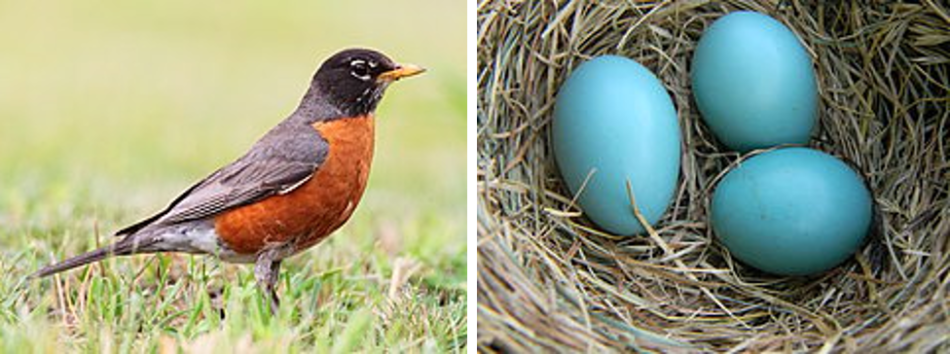
Images: American robin: Kristof vt/Wikipedia, CC BY-SA 3.0. Blue eggs: Laslovarga/Wikipedia, CC BY-SA 3.0
There is also another reason for this choice: protection from sunlight. The colourful shell is able to shield the growing embryo from harmful UV rays and also absorbs infrared rays, which allows the egg to maintain an optimal temperature for development of the embryo.[16]
Whether it comes from chemistry or physics, we can certainly say that in nature blue is never sad!
References
[1] Visible light spectrum: https://www.sciencelearn.org.nz/resources/47-colours-of-light
[2] David Lee (2010) Nature’s Palette, The Science of Plant Color. University of Chicago Press. ISBN: 9780226471051
[3] Tahoun M et al. (2021) Chemistry of porphyrins in fossil plants and animals. RSC Advances 11: 7552–7563. doi: 10.1039/D0RA10688G
[4] de Pascual-Teresa S, Sanchez-Ballesta MT (2008) Anthocyanins: from plant to health. RSC Advances 7: 281–299. doi: 10.1007/s11101-007-9074-0
[5] Shiono M, Matsugaki N, Takeda K (2005) Structure of the blue cornflower pigment. Nature. 436: 7052. doi: 10.1038/436791a
[6] Yoshida K, Mori M, Kondo T (2009) Blue flower color development by anthocyanins: from chemical structure to cell physiology. Nature Product Reports 26: 884–915. doi: 10.1039/b800165k
[7] Kohei K, Naonobu N, Suzuki M (2003) Flavonoid composition related to petal color in different lines of Clitoria ternatea. Phytochemistry. 64: 1133–1139. doi: 10.1016/s0031-9422(03)00504-1
[8] Shrestha M et al. (2021) Fragmentary blue: resolving the rarity paradox in flower colors. Frontiers in Plant Science 11. doi: 10.3389/fpls.2020.618203
[9] Shimoda M, Honda K-i (2013) Insect reactions to light and its applications to pest management. Applied Entomology and Zoology 48: 413–421. doi: 10.1007/s13355-013-0219-x
[10] Bagnara JT, Fernandez PJ, Fujii R (2017) On the blue coloration of vertebrates. Pigment Cell Research 20: 14–26. doi: 10.1111/j.1600-0749.2006.00360.x
[11] Wilts DB et al. (2014) Sparkling feather reflections of a bird-of-paradise explained by finite-difference time-domain. PNAS 12: 4363–4368. doi: 10.1073/pnas.1323611111
[12] Tadepalli S et al. (2017) Bio-optics and bio-inspired optical materials. Chemical Reviews 20: 12705–12763. doi: 10.1021/acs.chemrev.7b00153
[13] Saito A et al. (2006) Morpho-blue reproduced by nanocasting lithography. Proc. SPIE 6327, Nanoengineering: Fabrication, Properties, Optics, and Devices III, 63270Z; doi: 10.1117/12.679979
[14] Heather MW et al. (2016) Photonic multilayer structure of Begonia chloroplasts enhances photosynthetic efficiency. Nature Plants 2: 16162. doi: 10.1038/nplants.2016.162
[15] English PA, Montgomerie R (2011) Robin’s egg blue: Does egg color influence male parental care? Behavioral Ecology and Sociobiology 65: 1029–1036. doi: 10.1007/s00265-010-1107-9
[16] Lahti DC, Ardia DR (2016) Shedding light on bird egg color: pigment as parasol and the dark car effect. The American Naturalist 187: 547–563. doi: 10.1086/685780
Resources
- Read about how our eyes make sense of light.
- Watch a video summarizing how nature gets the blues.
- Read about iridescence and anti-predator defence.
- Read about the colour pink in nature and the chemistry behind it: Bettucci O (2022) Colour in nature: think pink. Science in School 57.
- Learn about the pigment indigo and have a go at extracting it at school: Farusi G (2012) Indigo: recreating Pharaoh’s dye. Science in School 24: 40–46.
- Use chromatography to explore the pigments that give leaves their colour: Tarragó-Celada J, Fernández Novell JM (2019) Colour, chlorophyll and chromatography. Science in School 47: 41–45.
- Make pH-sensitive inks from fruits and vegetables: Giraldi Shimamoto G, Vitorino Rossi A (2015) An artistic introduction to anthocyanin inks. Science in School 31: 32–36.
- Investigate electromagnetic waves by constructing a cereal-box spectrograph: Westra MT (2007) A fresh look at light: build your own spectrometer. Science in School 4: 30–34.
- Engage with biomimetic design to explore evolution: Toro S (2021) Biomimicry: linking form and function to evolutionary and ecological principles. Science in School 53.
- Explore chemical reactions using tea: Prolongo M, Pinto G (2021) Tea-time chemistry. Science in School 52.
- Exploring colour chemistry using smartphones: Montangero et al. (2015) Smartphones in the lab: how deep is your blue? Science in School 33: 38–41.





